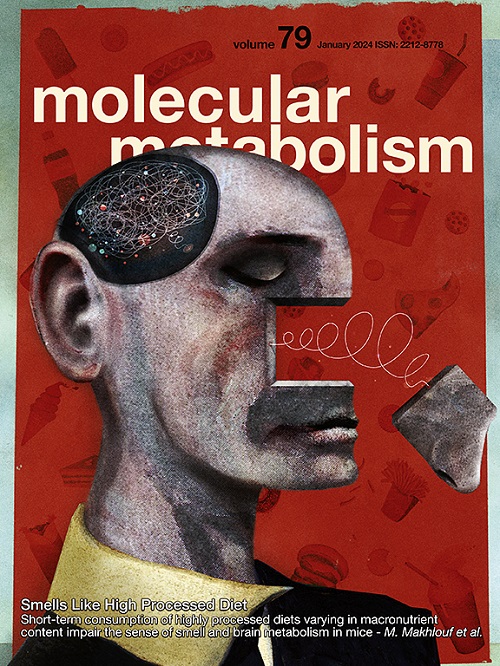Genetic and sex-specific regulation of mitochondrial function in gonadal and inguinal adipose tissue
IF 6.6
2区 医学
Q1 ENDOCRINOLOGY & METABOLISM
引用次数: 0
Abstract
Objective
Sex differences in adipose tissue impact metabolic health, but the underlying molecular mechanisms remain unclear. We previously identified a female-specific chr17 trans-eQTL hotspot regulating mitochondrial gene expression in gonadal white adipose tissue (gWAT). Here, we tested whether iWAT contributes comparably to sex differences in mitochondrial function and futile cycling.
Methods
We analyzed iWAT and gWAT from male and female mice across 58 genetically diverse Hybrid Mouse Diversity Panel (HMDP) strains fed a high-fat, high-sucrose diet. We assessed mitochondrial DNA (mtDNA), oxidative phosphorylation (OXPHOS) and futile cycle gene expression, performed genetic mapping, and measured respiration.
Results
In gWAT, females showed higher mtDNA, OXPHOS expression, and a female-specific chr17 trans-eQTL, correlating with metabolic traits. In contrast, iWAT lacked this hotspot and showed higher mtDNA, OXPHOS expression, and respiration in males. Lipid cycling genes (Lipe, Mgll, Pnpla2) were elevated in male iWAT, while Mpc1, Mpc2, and Pck1 were enriched in female gWAT. Ucp1 was higher in female gWAT but not sex-biased in iWAT. Alpl (TNAP), key creatine cycling gene, was upregulated in females in both depots, particularly in iWAT.
Conclusions
Female gWAT shows genetically driven mitochondrial regulation linked to metabolic protection, whereas male iWAT has higher mitochondrial content, OXPHOS expression, and respiration. Elevated lipolytic enzymes in male iWAT suggest greater FFA release, while higher pyruvate import and glyceroneogenesis genes in female gWAT favor FFA recycling. Alpl upregulation in females indicates sex-biased UCP1-independent thermogenesis. These depot- and sex-specific signatures reflect distinct metabolic strategies and highlight the need to consider both in adipose research.
性腺和腹股沟脂肪组织中线粒体功能的遗传和性别特异性调控。
目的:脂肪组织的性别差异影响代谢健康,但其潜在的分子机制尚不清楚。我们之前发现了一个雌性特异性的chr17反式eqtl热点,调节性腺白色脂肪组织(gWAT)中线粒体基因的表达。在这里,我们测试了iWAT是否对线粒体功能和无效循环的性别差异有相当的贡献。方法:我们分析了58个遗传多样性杂交小鼠多样性小组(HMDP)品系雄性和雌性小鼠的iWAT和gWAT,这些品系饲喂高脂肪、高糖饮食。我们评估了线粒体DNA (mtDNA)、氧化磷酸化(OXPHOS)和无效循环基因表达,进行了遗传作图,并测量了呼吸。结果:在gWAT中,女性表现出更高的mtDNA, OXPHOS表达和女性特有的chr17反式eqtl,与代谢性状相关。相比之下,iWAT缺乏这一热点,在雄性中表现出更高的mtDNA、OXPHOS表达和呼吸。脂质循环基因(Lipe, mgl, Pnpla2)在男性gWAT中升高,而Mpc1, Mpc2和Pck1在女性gWAT中富集。Ucp1在女性gWAT中较高,但在iWAT中无性别偏倚。肌酸循环的关键基因Alpl (TNAP)在两个试验点的雌性中均上调,尤其是在iWAT中。结论:女性iWAT显示出与代谢保护相关的遗传驱动的线粒体调控,而男性iWAT具有更高的线粒体含量、OXPHOS表达和呼吸。男性高脂解酶表明FFA释放量大,而女性高丙酮酸输入和甘油生成基因有利于FFA循环。雌性的Alpl上调表明性别偏倚的不依赖ucp1的产热作用。这些储存特异性和性别特异性的特征反映了不同的代谢策略,并强调了在脂肪研究中同时考虑两者的必要性。
本文章由计算机程序翻译,如有差异,请以英文原文为准。
求助全文
约1分钟内获得全文
求助全文
来源期刊

Molecular Metabolism
ENDOCRINOLOGY & METABOLISM-
CiteScore
14.50
自引率
2.50%
发文量
219
审稿时长
43 days
期刊介绍:
Molecular Metabolism is a leading journal dedicated to sharing groundbreaking discoveries in the field of energy homeostasis and the underlying factors of metabolic disorders. These disorders include obesity, diabetes, cardiovascular disease, and cancer. Our journal focuses on publishing research driven by hypotheses and conducted to the highest standards, aiming to provide a mechanistic understanding of energy homeostasis-related behavior, physiology, and dysfunction.
We promote interdisciplinary science, covering a broad range of approaches from molecules to humans throughout the lifespan. Our goal is to contribute to transformative research in metabolism, which has the potential to revolutionize the field. By enabling progress in the prognosis, prevention, and ultimately the cure of metabolic disorders and their long-term complications, our journal seeks to better the future of health and well-being.
 求助内容:
求助内容: 应助结果提醒方式:
应助结果提醒方式:


